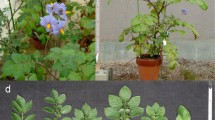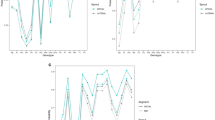Summary
The techniques of microspore and protoplast regeneration starting from dihaploid Solanum tuberosum plants has been improved to such an extent that the production of more than 2000 microspore derived A1 plant lines and of several hundred protoplast derived plantlets has become possible. Further, from the dihaploid Solanum species S. phureja the regeneration of microspores to plants, and from the species S. infundibuliforme, S. sparsipilum and S. tarijense the regeneration of protoplasts to calluses, has been achieved. The plants descending from the two single cell culture systems are compared with reference to phenotypic markers and economic qualities. Some principles characteristic for either microspore or protoplast derived plants are examined and their significance is discussed. The results are compiled into an extended analytical synthetic breeding scheme based on a stepwise reduction of the autotetraploid to the monohaploid level and a subsequent controlled combination to a new synthetic completely heterozygous tetraploid potato.
Similar content being viewed by others
Literature
Binding, H.; Nehls, R.; Schieder, O.; Sopory, S.K.; Wenzel, G.: Regeneration of mesophyll protoplasts isolated from dihaploid clones of Solanum tuberosum. Physiol. Plant. 43, 52–54 (1978)
Breukelen, E.W.M. van; Ramanna, M.S.; Hermsen, J.G.Th.: Monohaploids (n=x=12) from autotetraploid Solanum tuberosum (2n=4x=48) through two successive cycles for female parthenogenesis. Euphytica 24, 567–574 (1975)
Chase, S.S.: Analytical breeding in Solanum tuberosum L. Can. J. Genet. Cytol. 5, 359–363 (1963)
Foroughi-Wher, B.; Wilson, H.M.; Mix, G.; Gaul, H.: Monohaploid plants from anthers of dihaploid genotype of Solanum tuberosum L. Euphytica 26, 361–368 (1977)
Frandsen, N.O.: Die Plastidenzahl als Merkmal bei der Kartoffel. Theor. Appl. Genet. 38, 153–167 (1968)
Grun, P.L.; Chu, J.: Development of plantlets from protoplasts of Solanum (Solanaceae). Amer. J. Bot. 65, 538–543 (1978)
Hermsen, J.G.Th.; Verdenius, J.: Selection from Solanum tuberosum group phureja of genotypes combining high-frequency haploid induction with homozygosity for embryo spot. Euphytica 22, 183–189 (1973)
Houghas, R.W.; Peloquin, S.J.; Gabert, A.C.: Effect of seed-parent and pollinator on frequency of haploids in Solanum tuberosum. Crop sci. 4, 593–595 (1964)
Jacobsen, E.; Sopory, S.K.: The influence and possible recombination of genotypes on the production of microspore embryoids in anther cultures of Solanum tuberosum and dihaploid hybrids. Theor. Appl. Genet. 52, 119–123 (1978)
Matern, U.; Strobel, G.; Shepard, J.: Reaction to phytotoxins in a potato population derived from mesophyll protoplasts. Proc. Nat. Acad. Sci. (USA) 75, 4935–4939 (1978)
Melchers, G.: Einige genetische Gesichtspunkte zu sogenannten Gewebekulturen. Ber. Dt. Bot. Ges. 78, 21–29 (1965)
Melchers, G.: Haploids for breeding by mutation and recombination. In: Polyploidy and induced mutations in plants breeding, 221–231. Vienna IAEA 1974
Melchers, G.: Potatoes for combined somatic and sexual breeding methods; plants from protoplasts and fusion of protoplasts of potato and tomato. In: Production of natural compounds by cell culture methods. (eds. Alfermann, A.W.; Reinhard, E.), 306–311 GSF München: 1978
Melchers, G.; Bergmann, L.: Untersuchungen an Kulturen von haploiden Geweben von Antirrhinum majus. Ber. Dt. Bot. Ges. 71, 459–573 (1958)
Melchers, G.; Sacristán, M.D.; Holder, A.A.: Somatic hybrid plants of potato and tomato regenerated from fused protoplasts. Carlsberg Res. Commun. 43, 203–218 (1978)
Mendiburu, A.O.; Peloquin, S.J.; Mok, D.W.S.: Potato breeding with haploids and 2n gametes. In: Haploids in higher plants (ed. K.J. Kasha), 249–258. University Guelph: 1974
Nagata, T.; Takebe, I.: Plating of isolated tobacco mesophyll protoplasts on agar medium. Planta 99, 12–20 (1971)
Nakamura, A.; Yamada, T.; Kadotani, N.; Itagaki, R.: Improvement of flue-cured tobacco variety MC 1610 by means of haploid breeding method and some problems of this method. In: Haploids in higher plants (ed. Kasha, K.J.), 277–278. University Guelph: 1974
Nitzsche, W.; Wenzel, G.: Haploids in plant breeding. Berlin, Hamburg: P. Parey 1977
Ross, H.; Jacobsen, E.: Beobachtungen an Nachkommenschaften aus Kreuzungen zwischen dihaploiden und tetraploiden Kartoffelformen; Samenzahl, Ploidiestufe sowie Spaltungsverhältnisse des Gens für extreme Resistenz gegen das X-Virus (Rxacl). Z. Pflanzenzücht. 76, 265–280 (1976)
Schieder, O.: Isolation of mutants with altered pigments after irradiating haploid protoplasts of Datura innoxia Mill. with X-rays. Molec. gen. Genet. 149, 251–254 (1976)
Schieder, O.: Somatic hybrids of Datura innoxia Mill. + Datura discolor Bernh. and of Datura innoxia Mill. + Datura stramonium L. var tatula L. Molec. gen. Genet. 162, 113–119 (1978)
Sopory, S.K.; Jacobsen, E.; Wenzel, G.: Production of monohaploid embryoids and plantlets in cultured anthers of Solanum tuberosum. Plant Sci. Lett. 12, 47–54 (1978)
Takebe, I.; Labib, G.; Melchers, G.: Regeneration of whole plants from isolated mesophyll protoplasts of tobacco. Naturwissenschaften 58, 318–320 (1971)
Wenzel, G.; Hoffmann, F.; Thomas, E.: Heterozygous microsporederived plants in rye. Theor. Appl. Genet. 48, 205–208 (1976)
Wenzel, G.; Hoffmann, F.; Thomas, E.: Increased induction and chromosome doubling of androgenetic haploid rye. Theor. Appl. Genet. 51, 81–86 (1977)
Wenzel, G.; Sopory, S.K.: Production and utilization of dihaploid or monohaploid potatoes. In: Production of natural compounds by cell culture methods (eds. Alfermann, A.W.; Reinhard, E.), 303–305 GSF München: 1978
Yin, K.-Ch.; Hsü, Ch.; Y. Chu, Ch.; Y. Pi, F.; T. Wang, S.; Y. Liu, T.; Ch. Chu, Ch.; Ch. Wang, Ch.; S. Sun, Ch.: A study of the new cultivar of rice raised by haploid breeding method. Scientia Sinica 19, 227–242 (1976)
Author information
Authors and Affiliations
Additional information
Communicated by H.F. Linskens
Rights and permissions
About this article
Cite this article
Wenzel, G., Schieder, O., Przewozny, T. et al. Comparison of single cell culture derived Solanum tuberosum L. plants and a model for their application in breeding programs. Theoret. Appl. Genetics 55, 49–55 (1979). https://doi.org/10.1007/BF00285189
Received:
Issue Date:
DOI: https://doi.org/10.1007/BF00285189




